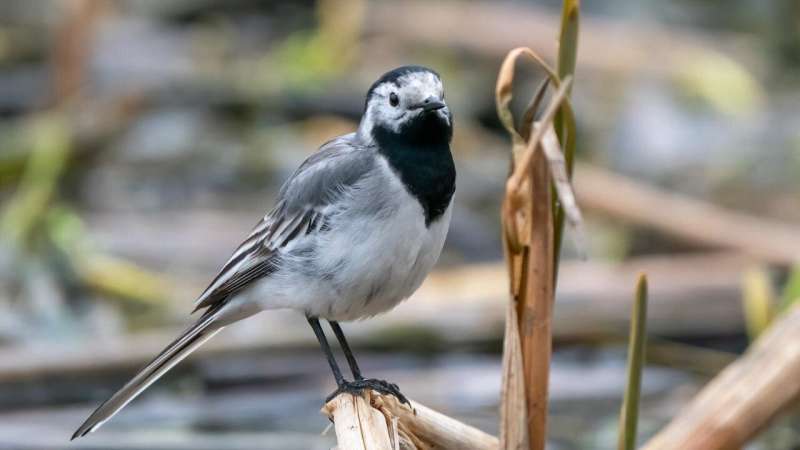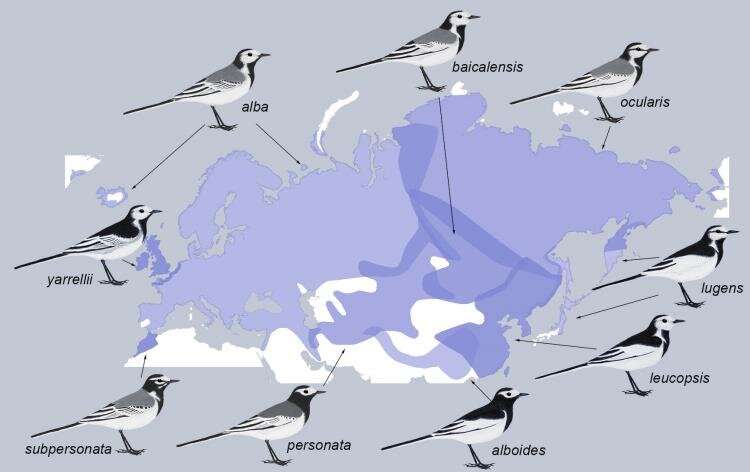Credit: University of Colorado at Boulder
For birds, simple does not always equal simple—and that difference can create interesting variations in plumage, according to new findings from University of Colorado Boulder researchers and their colleagues.
This new research, out this week in Nature Communications, looked at the hybrid zone of two subspecies of white wagtails, a bird commonly found across Eurasia, to understand the relationship between genomes and physical (or phenotypic) traits and the role those play in reproduction between the two subspecies.
What they found is that while the genetic architecture of the traits in question—head and neck plumage—is fairly straightforward, the way these physical traits are inherited is not. Rather than commonly assumed models of inheritance, these traits instead use an inheritance pattern called epistasis (when one gene modifies the phenotype of another gene) and partial dominance (when the dominant form of a gene does not completely mask the effects of the recessive part).
These findings, while interesting to evolutionary biology, could also have important implications for how scientists understand not only the genetics of this bird's plumage, but animal coloration broadly.
"Quite often, you have a lot of noise in the genomic data, and it's hard to be confident that those associations that you find are actually causal," said Georgy Semenov, a postdoctoral researcher in ecology and evolutionary biology (EBIO) at CU Boulder and the lead researcher on the project.
"The fact that we find that it's a pretty clear architecture governed by partial dominance and epistasis is very interesting, and it's important for how we think about finding genes associated with phenotypic traits. Even in a simple case, it's not that simple."
Credit: University of Colorado at Boulder
Birds hybridize quite often throughout the world. When they do, as long as the hybrids aren't sterile, there's a chance they'll share their new genetic factors from the other species with their parental species (a process called introgression).
This sharing can play an important role in how new species form, but it also can affect existing taxa with uneven sharing of these new genes across the genome. It's thought that this inconsistency can sometimes lead a trait to be genetically displaced far from where it might otherwise be found, but this phenomenon is, by and large, poorly understood.
This new research, though, aimed to fill in that gap, so it examined a bird common in the northern hemisphere: the white wagtail.
The white wagtail is a small songbird with nine subspecies stretching across Eurasia, from North Africa to Alaska. For this study, they looked at the hybrid zone between two subspecies of white wagtails—alba and personata.
Semenov and colleagues previously sampled a 3000 km transect of that hybrid zone which stretches across Siberia, as well as remote, isolated populations.
Researchers found that there was only one trait that seemed to be involved in reproductive isolation between the two subspecies: head and neck plumage. They also found very simple segregation patterns which, the researchers say, suggests that it is guarded by only a few genes of large effect far from where they should reside in the genome.
The white wagtail has nine subspecies scattered throughout Eurasia. Credit: University of Colorado at Boulder
"It's not very often when you have such situations where there's a very clear separation between a trait of interest and the rest of the genome," Semenov commented.
While the results were to some degree straightforward, the cause, the researchers say, was not. To test those results to see the role that introgression may play, they then used a method modeled off of previous work with warblers and finches by Scott Taylor, an assistant professor of EBIO at CU Boulder, and colleagues, to dissect the genetic architecture of only that trait from the whole genome of 82 of those previously sampled birds, 62 of which came from the hybrid zone.
They found that the trait is transmitted through partial dominance and epistasis between two small genomic regions, which, the researchers say, might explain its asymmetric introgression.
While interesting for the evolution of this bird in particular, pinpointing these two genomic regions not only provides insight for how variation in plumage can arise in the first place, but also animal coloration broadly speaking.
"Although this pattern of displacement has been seen in other systems, without knowing the genetic basis of the displaced trait, it is hard to understand how the pattern could arise," said Taylor, the senior author on the paper.
"We now have a good handle on what is happening in this system."
More information: Georgy A. Semenov et al. Asymmetric introgression reveals the genetic architecture of a plumage trait, Nature Communications (2021). DOI: 10.1038/s41467-021-21340-y
Journal information: Nature Communications
Provided by University of Colorado at Boulder


























